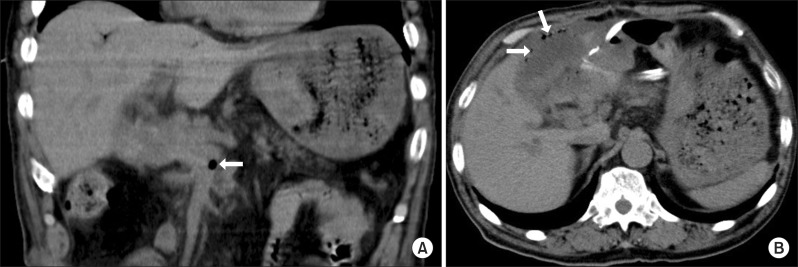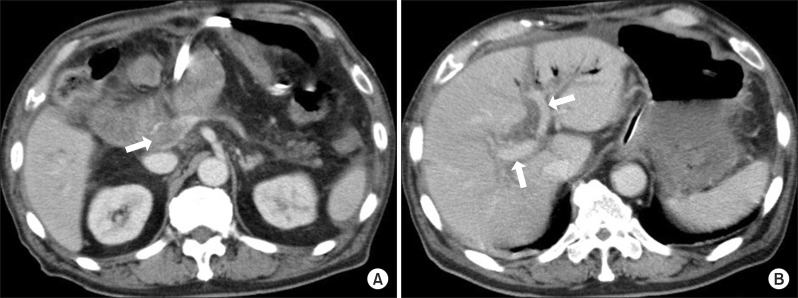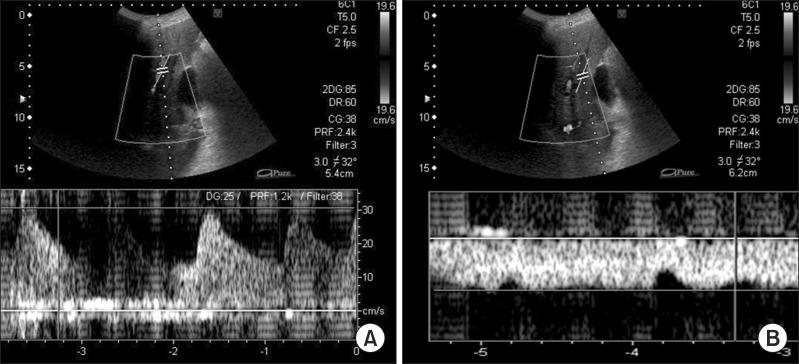Korean J Hepatobiliary Pancreat Surg.
2016 Feb;20(1):44-47. 10.14701/kjhbps.2016.20.1.44.
Postoperative portal vein thrombosis and gastric hemorrhage associated with late-onset hemorrhage from the common hepatic artery after pancreaticoduodenectomy
- Affiliations
-
- 1Department of General Surgery, Juntendo University Nerima Hospital, Tokyo, Japan. nobei@juntendo.ac.jp
- KMID: 2243031
- DOI: http://doi.org/10.14701/kjhbps.2016.20.1.44
Abstract
- Portal vein thrombosis (PVT) is a rare but serious postoperative complication of pancreaticoduodenectomy (PD). We reported a case of late-onset postoperative PVT with hemorrhage from the common hepatic artery (CHA) in a 73-year-old man who underwent pylorus-preserving pancreaticoduodenectomy (PPPD) for duodenum papilla cancer, followed by reconstruction using the modified Child's technique. The pancreaticojejunostomy was achieved by end-to-side, 2-layer invagination anastomosis without pancreatic duct stenting. Drain removal and hospital discharge were scheduled on postoperative day (POD) 18, but blood-stained fluid in the drain and sudden hematemesis were noted. Emergency surgery was performed because PVT and imaging findings were suggestive of necrosis of the lifted jejunum. Although no jejunal necrosis was identified during surgery, bleeding from the side of the CHA was detected and the bleeding point was suture-closed to achieve hemostasis. We suspected late-onset postoperative arterial hemorrhage and subsequent hematoma formation, which caused portal vein compression and PVT formation. We chose a conservative treatment strategy for PVT, taking into account the operation time, intraoperative vital signs and blood flow in the portal vein. Despite the complicated postoperative course, he was discharged home in a fully ambulatory state on POD 167.
Keyword
MeSH Terms
Figure
Reference
-
1. Monge JJ, Judd ES, Gage RP. Radical pancreatoduodenectomy: a 22-year experience with the complications, mortality rate, and survival rate. Ann Surg. 1964; 160:711–722. PMID: 14210370.2. Mergenthaler FW, Harris MN. Superior mesenteric vein thrombosis complicating pancreatoduodenectomy: successful treatment by thrombectomy. Ann Surg. 1968; 167:106–111. PMID: 5635177.3. Thomas RM, Ahmad SA. Management of acute post-operative portal venous thrombosis. J Gastrointest Surg. 2010; 14:570–577. PMID: 19582513.
Article4. Bassi C, Dervenis C, Butturini G, Fingerhut A, Yeo C, Izbicki J, et al. International Study Group on Pancreatic Fistula Definition. Postoperative pancreatic fistula: an international study group (ISGPF) definition. Surgery. 2005; 138:8–13. PMID: 16003309.
Article5. Whipple AO, Parsons WB, Mullins CR. Treatment of carcinoma of the ampulla of vater. Ann Surg. 1935; 102:763–779. PMID: 17856666.6. Cameron JL, Riall TS, Coleman J, Belcher KA. One thousand consecutive pancreaticoduodenectomies. Ann Surg. 2006; 244:10–15. PMID: 16794383.
Article7. Gouillat C, Chipponi J, Baulieux J, Partensky C, Saric J, Gayet B. Randomized controlled multicentre trial of somatostatin infusion after pancreaticoduodenectomy. Br J Surg. 2001; 88:1456–1462. PMID: 11683740.
Article8. Büchler MW, Wagner M, Schmied BM, Uhl W, Friess H, Z'graggen K. Changes in morbidity after pancreatic resection: toward the end of completion pancreatectomy. Arch Surg. 2003; 138:1310–1314. PMID: 14662530.9. Balcom JH 4th, Rattner DW, Warshaw AL, Chang Y, Fernandez-del Castillo C. Ten-year experience with 733 pancreatic resections: changing indications, older patients, and decreasing length of hospitalization. Arch Surg. 2001; 136:391–398. PMID: 11296108.10. Büchler MW, Friess H, Wagner M, Kulli C, Wagener V, Z'Graggen K. Pancreatic fistula after pancreatic head resection. Br J Surg. 2000; 87:883–889. PMID: 10931023.
Article11. Choi SH, Moon HJ, Heo JS, Joh JW, Kim YI. Delayed hemorrhage after pancreaticoduodenectomy. J Am Coll Surg. 2004; 199:186–191. PMID: 15275871.12. Suc B, Msika S, Fingerhut A, Fourtanier G, Hay JM, Holmières F, et al. French Associations for Surgical Research. Temporary fibrin glue occlusion of the main pancreatic duct in the prevention of intra-abdominal complications after pancreatic resection: prospective randomized trial. Ann Surg. 2003; 237:57–65. PMID: 12496531.13. Virchow RR. Cellular pathology. London: Churchill;1860.
- Full Text Links
- Actions
-
Cited
- CITED
-
- Close
- Share
- Similar articles
-
- Hepatic artery pseudoaneurysm after pancreaticoduodenectomy treated with coil embolization in combination with portomesenteric venous stenting
- Balloon Occlusion Retrograde Transvenous Obliteration of Gastric Varices in Two Non-Cirrhotic Patients with Portal Vein Thrombosis
- Chronic Pancreatitis Associated with Liver Infarction and Inferior Pancreaticoduodenal Artery Pseudoaneurysm
- Isolated Splenic Vein Thrombosis Associated with Acute Pancreatitis
- A Case of Hepatocellular Carcinoma with Portal Vein Tumor Thrombosis Treated by Hepatic Artery Injection Chemotherapy and Radiotherapy




